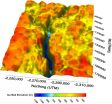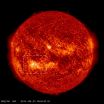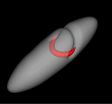(Press-News.org) The natural photo degradation of diazepam (valium) and similar medicines – followed by bacterial breakdown – may reduce their potentially harmful impact on the UK's freshwater environment, a team of researchers has said.
Diazepam – used to treat anxiety and other similar conditions – has been detected in rivers across the UK and Europe, having been released from waste water treatment plants. At the levels recorded, it has the potential to produce harmful ecological effects in surface waters, including changing the behaviour of fish shoals and their ability to sense danger from predators.
Now, experts in the Biogeochemistry Research Centre at Plymouth University and the Institute of Integrative Biology at the University of Liverpool, with funding from the Natural Environment Research Council, have identified a bacterial breakdown pathway. They say it could reduce the concentrations of diazepam and similar chemicals that reach rivers and subsequently flow into the world's oceans.
Dr Alan Tappin, Research Fellow at Plymouth University and the lead researcher on the project, said: "Contamination of aquatic systems by human and veterinary pharmaceuticals now appears to be extensive; however there is a significant lack of knowledge of their aquatic transport and fate, and effects on fish and aquatic organisms. Diazepam is seen as an essential drug by the World Health Organisation, but it is excreted into waste water treatment works because people take more than can be metabolised in their body. Previous research has shown that similar chemicals can have a negative effect on the behaviour of freshwater fish, and there is potential for them to impact marine ecosystems. Understanding diazepam's chemical behaviour in the environment is therefore crucial."
For the study, researchers in Plymouth and Liverpool recreated river environments in laboratories using water and bacteria taken from the Rivers Tamar and Mersey.
Previous research at Plymouth University had demonstrated that diazepam and similar compounds could be quickly converted to benzophenones when exposed to sunlight. As a result, the current research team exposed bacteria to diazepam and ACB (a benzophenone) to analyse whether the medication could be broken down by natural microbes. Experiments were also conducted to see if the compounds were preferred by bacteria even when other sources of energy were present.
The researchers found that diazepam was not readily attacked by bacteria, particularly when other compounds were available as a source of energy. However, ACB, its photo-degradation product, was extensively attacked by the bacteria from both rivers and completely broken down into small, natural molecules, including ammonium.
Dr Mark Fitzsimons, Associate Professor in Organic Geochemistry at Plymouth, and Principal Investigator for the project added: "Significant ACB degradation occurred in every experiment, leading us to propose that the aquatic photo-degradation of diazepam to ACB, followed by breakdown of ACB, is a key removal pathway for these emerging contaminants. As ACB is photo-produced by several benzodiazepines used as medicines, this pathway is relevant for their removal within freshwater environments. Our study builds on previous work within the Biogeochemistry Research Centre demonstrating the conversion of diazepam to ACB in sunlit surface waters. Given the current concern around the impact of benzodiazepines on river environments, our study can make an important contribution to assessing the risk posed by diazepam and similar medicines to the environment."
INFORMATION:
Bacteria may have ability to reduce impact of diazepam on UK river environments
2014-09-30
ELSE PRESS RELEASES FROM THIS DATE:
Entanglement made tangible
2014-09-30
Quantum entanglement refers to the "pairing" of two subatomic particles in such a way that they form a whole quantum system. Interest in entanglement is increasing today, as it challenges the foundations of quantum mechanics itself, and is also key for achieving quantum information processing and communication. Entanglement is thought to exist up to the everyday, or "macroscopic" realm – according to the predictions of quantum physics – but experimental proposals to show this often involve conditions that are difficult to achieve in today's labs. Publishing in Physical ...
Shape up quickly -- applies to fish, too!
2014-09-30
Fish can live in almost any aquatic environment on Earth, but when the climate changes and temperatures go up many species are pushed to the limit. The amount of time needed to adjust to new conditions could prove critical for how different species cope in the future, reveals a new study from researchers at the University of Gothenburg, published in the scientific journal Proceedings of the Royal Society B.
Climate change continues apace thanks to increasing levels of greenhouse gases in the atmosphere. The greenhouse effect has led not only to an increase in average ...
Dietary polyunsaturated fatty acids linked to smaller risk of coronary heart disease
2014-09-30
A recent study completed at the University of Eastern Finland shows that dietary polyunsaturated fatty acids may reduce the risk of coronary heart disease. The sources of polyunsaturated fatty acids include fish, vegetable oils, and nuts. The findings were published in Arteriosclerosis, Thrombosis & Vascular Biology, an esteemed journal of the American Heart Association.
Recent studies have not found an association between the consumption of saturated fats and the risk of cardiovascular diseases. It seems that the mere reduction of saturated fats from the diet does not ...
On the trail of the truffle flavor
2014-09-30
This news release is available in German. FRANKFURT. Truffles, along with caviar, are among the most expensive foods in the world. Because they grow underground, people use trained dogs or pigs to find them. But the distinctive smell of truffles is not only of interest to gourmets. A group of German and French scientists under the direction of the Goethe University Frankfurt have discovered that the smell of white truffles is largely produced by soil bacteria which are trapped inside truffle fruiting bodies.
White truffles from the Piedmont region in Italy can reach ...
NASA ocean data shows 'climate dance' of plankton
2014-09-30
The greens and blues of the ocean color from NASA satellite data have provided new insights into how climate and ecosystem processes affect the growth cycles of phytoplankton—microscopic aquatic plants important for fish populations and Earth's carbon cycle.
At the bottom of the ocean's food chain, phytoplankton account for roughly half of the net photosynthesis on Earth. Their photosynthesis consumes carbon dioxide and plays a key role in transferring carbon from the atmosphere to the ocean. Unlike the plant ecosystems on land, the amount of phytoplankton in the ocean ...
NASA support key to glacier mapping efforts
2014-09-30
Thanks in part to support from NASA and the National Science Foundation, scientists have produced the first-ever detailed maps of bedrock beneath glaciers in Greenland and Antarctica. This new data will help researchers better project future changes to glaciers and ice sheets, and ultimately, sea level.
Researchers at the Center for Remote Sensing of Ice Sheets, or CReSIS, at the University of Kansas in Lawrence, Kansas, recently built detailed maps of the terrain beneath Greenland's Jakobshavn Glacier and Byrd Glacier in Antarctica. The results of this study were published ...
NASA-funded rocket has 6 minutes to study solar heating
2014-09-30
On Sept. 30, 2014, a sounding rocket will fly up into the sky – past Earth's atmosphere that obscures certain wavelengths of light from the sun -- for a 15-minute journey to study what heats up the sun's atmosphere. This is the fourth flight for the Very high Angular Resolution Ultraviolet Telescope, or VAULT, will launch from the White Sands Missile Range near Las Cruces, New Mexico.
The instrument, now called VAULT2.0, has been refurbished with new electronics and an imaging detector to capture images more frequently than before. While in space, VAULT2.0 will observe ...
Deceptive-looking vortex line in superfluid led to twice-mistaken identity
2014-09-30
So long, solitons: University of Chicago physicists have shown that a group of scientists were incorrect when they concluded that a mysterious effect found in superfluids indicated the presence of solitons—exotic, solitary waves. Instead, they explain, the result was due to more pedestrian, whirlpool-like structures in the fluid. They published their explanation in the Sept. 19 issue of Physical Review Letters.
The debate began in July 2013, when a group of scientists from the Massachusetts Institute of Technology published results in Nature showing a long-lived structure ...
New discovery approach accelerates identification of potential cancer treatments
2014-09-30
ANN ARBOR—Researchers at the University of Michigan have described a new approach to discovering potential cancer treatments that requires a fraction of the time needed for more traditional methods.
They used the platform to identify a novel antibody that is undergoing further investigation as a potential treatment for breast, ovarian and other cancers.
In research published online in the Proceedings of the National Academy of Sciences, researchers in the lab of Stephen Weiss at the U-M Life Sciences Institute detail an approach that replicates the native environment ...
Gene doubling shapes the world: Instant speciation, biodiversity, and the root of our existence
2014-09-30
What do seedless watermelon, salmon, and strawberries all have in common? Unlike most eukaryotic multicellular organisms that have two sets of chromosomes and are diploid, these organisms are all polyploid, meaning they have three or more sets of chromosomes—seedless watermelon and salmon have 3 and 4 sets of chromosomes, respectively, and strawberries have 10! While this might seem surprising, in fact most plant species are polyploid. Polyploidy, or genome doubling, was first discovered over a century ago, but only recently, with the development of molecular tools, has ...





